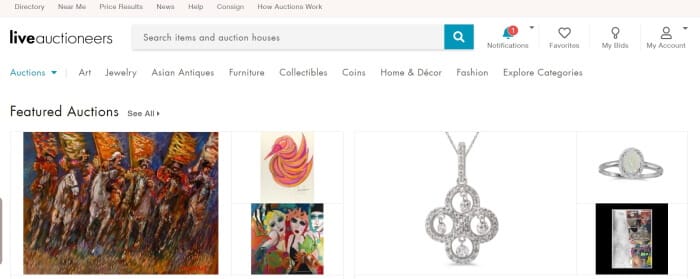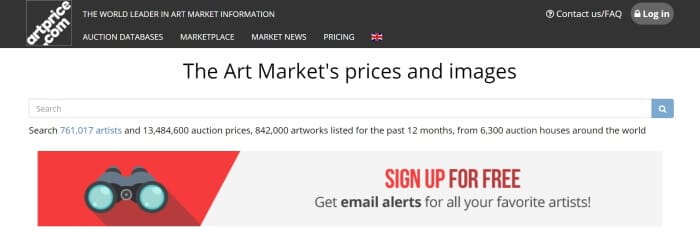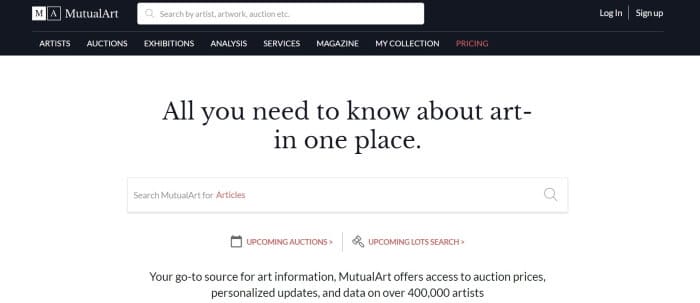Art such as original oil on canvas paintings is notoriously difficult to appraise. The reason being that each painting is unique. For example, a painting may sell for $1 million, but the next time a painting from the same artist goes on auction, it may only fetch $700,000.
This does not mean that it’s impossible to appraise or evaluate fine art. It might not be an exact science, but following the correct methodology will put you in the right ballpark.
In this article, we’ll shed some light on how you can get an idea of how much that old painting or sculpture you inherited from your grandmother or bought at a yard sale is worth.

An oil on canvas painting by German-American painter Albert Bierstadt (1830 – 1902).
Factors That Determine the Value of Art
Some of the main factors that will determine what your art is worth include:
Name of Artist – A painting or sculpture isn’t necessarily valuable only because it’s old or well-executed. Work from some artists is a lot more valuable and in demand than work from others.
Note: Deciphering a signature can sometimes be hard. Many artists don’t use their full name. There are sites like Artists’ Signatures that can assist you to decipher a signature for a fee.
Provenance – Who owned it before? Was it previously sold at auction, and if so, for how much did it sell? Has it been featured in art publications? Has it ever been appraised or evaluated?
Condition – The condition of an artwork plays a major role in how much it’s worth. The closer it is to its original condition, the better. For example, a painting is typically more valuable if it’s still in its original frame.
Scarcity – Some artists are prolific. If a lot of work from an artist is available on the market, it will often be less valuable than if the artist wasn’t so prolific. It’s one of the reasons why the price of paintings typically increases after the death of the painter.
Size – Large paintings or sculptures are often worth more than smaller ones by the same artist. They require more attention to detail and take longer to create.
Timeline – Most artists go through several stages during their life. Paintings created early on in a painter’s life often have a lower or higher value than paintings done closer to the end of a painter’s life.
Content & Subject Matter – What’s being depicted in a painting and the story behind it can make it more or less desirable. And this will reflect in the price people are willing to pay for it.
Certificate of Authenticity – There are many forgeries on the market and being able to produce a certificate of authenticity from a reputable authenticator makes a difference.
Market Conditions – Art doesn’t always sell well year in and year out. Some years are better than others. In addition, a once-popular artist may quickly fall out of favor with the market as works by other artists become more collectible.
Can You Trust Estimates of Auction Houses?
Artwork that goes on auction will normally have a “Low Estimate” and a “High Estimate” given by the auction house. You would expect renowned auction houses that specialize in art to come up with fairly accurate estimates. However, this isn’t always the case.

Source: artworldinsights.com (2019)
According to research done by Art World Insights, the average difference between low and high estimates is about 38%. In addition, 20% of lots fail to find a new home, and another 8% – 18% sell outside the valuation range.
The above variances are huge!
It’s one of the reasons why pawn shops that specialize in artwork have to take extra care when evaluating paintings. Unlike auction houses that carry no risk and that can get away with a 38% variation between low and high estimates, pawn shops have to put money on the table.
Note: Maxferd pawn shops such as our Beverly Hills pawn shop and San Francisco pawn shop have both internal and external art experts. Don’t hesitate to contact us if you want to pawn or sell your art.
Find Out What Your Art Is Worth
One of the best ways to help establish the market value of your art is to look at what similar lots sold for at auction. For example, look at what a painting by the same artist sold for. The painting should be about the same size, in the same condition, and from the same time period.
Here are some tools and resources that will help you to determine what art by the same artist sold for on auction:
LiveAuctioneers.com

LiveAuctioneers has a database with more than 29 million results of what items, including art, sold for on auctions all over the world.
Note: It’s the only one on the list that’s free to use.
Invaluable.com

Invaluable is a leading online marketplace for fine art, antiques and collectibles. They have partnered with over 5,000 auction houses all over the world and have a database of 66+ million price records.
ArtPrice.com

ArtPrice has a database of 759,996 artists and 13,484,600 auction prices from 6,300 auction houses around the world.
askART.com

askART has a database that contains millions of auction records and prices for 350,000+ artists dating back to 1987.
FindArtInfo.com

FindArtInfo has a database of 440,130 artists and 3,816,701 art prices. It also contains 369,596 signatures and 2,294,500 photos of artwork. You can run a basic search for free, but to get detailed information you need to subscribe.
MutualArt.com

MutualArt offers access to auction prices of over 400,000 artists and 20,000 art venues. All data is manually screened to ensure its accuracy and integrity.
That’s a Wrap
Finding out what your art is worth can be difficult and time-consuming. And if you don’t follow the right methodology, the estimate you arrive at could be totally inaccurate. However, by following the tips and advice shared in this article, you’ll get a more accurate ballpark figure.
If you have any questions about art you want to sell, pawn, or have evaluated – don’t hesitate to contact Maxferd.
Call us at (800) 888-7296 or visit one of our five locations in San Francisco and Los Angeles to find out how we can assist you.

